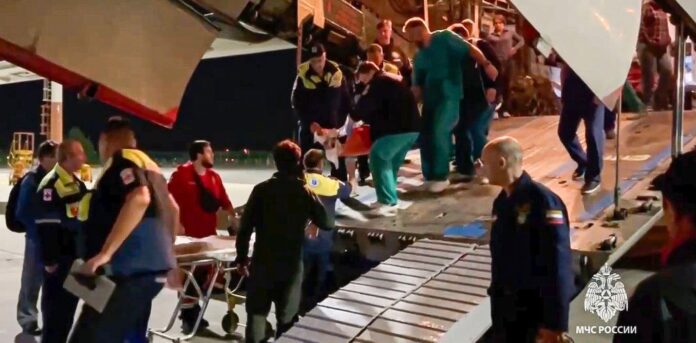‘Pogrom’ in Dagestan: the worrying signs of resurging antisemitism in Russia
By George Gilbert, University of Southampton
Dagestan – the “land of the mountains” – is a multi-ethnic Russian republic situated in the north Caucasus of eastern Europe, along the Caspian Sea. A place of stunning landscapes, it is a deeply troubled region.
On October 29, a crowd at Makhachkala airport in Dagestan’s capital city reportedly went on the rampage. Men dressed in black held Palestinian flags and claimed to be searching for “Jews” that had just arrived on a flight from Tel Aviv.
What followed were chaotic scenes: the crowd looted airport kiosks and chased after a bus. Shots were fired and some men even peered into the turbine of the landed plane, convinced their targets were hidden there.
In fact, there weren’t many Jews on the flight, but a rumour had circulated that the plane’s passengers included children who had received medical treatment in Israel.
This troubling episode would stir any observer of international affairs. But having carried out research on late imperial Russia, I was immediately struck by similarities between the pogrom waves seen in the late 19th and early 20th centuries and this latest event. It’s a comparison drawn by a number of contemporary commentators.
With the obvious caveat that this is not a like-for-like scenario, some comparative thinking and historical context can help us understand aspects of the latest alarming mob violence, which I argue could be accurately described as an attempted pogrom.
Looking at the wider community can provide some answers. Pogroms – outbreaks of mass violence directed against a minority religious, ethnic or social group – in Russia’s late imperial period tended to occur in areas with marked social problems, inequalities and inter-ethnic tensions. They were always places where the imperial centre – the tsar and local administrators – did not govern effectively or consistently.
Dagestan’s economy has suffered in the post-Soviet era, and has had its own crisis of power. It is apparent that local administrators have not met the needs of communities in demographically complex areas. There is high unemployment – particularly among the young – and, per person, it is the highest contributing area in the world to Islamic State.
Poverty and unemployment was the background to Odesa’s pogrom of 1871, in which a mob stormed Jewish parts of the city targeting Jewish shops and businesses, and to the wave of violence from 1903-6 that encompassed settlements such as Chişinău (Kishinev) in Bessarabia, and Gomel and Orsha in Belarus. Unstable employment and political instability provided further motivating factors.
Incitement to violence
Unemployment alone is certainly not enough to explain such events. One must also consider the wider environment, including the impact of the media. One notable element of the recent violence is that it was reportedly orchestrated on a Telegram channel called “Morning Dagestan”, which is said to have spread rumours about a “Jewish invasion”.
In the 19th century, the impact of the anti-Jewish press was powerful. Newspapers such as Kievlianin (The Kievan) and Novoe vremia (The New Times) stirred up resentment with lurid and fabricated tales of various outrages committed by Russia’s Jews, including tales of the “blood libel” – the disgracefully widespread myth about Jewish practices involving the sacrifices of young Christian boys.

Such stories led researchers away from earlier conclusions that the tsarist regime had orchestrated the pogroms, and instead illuminated their largely spontaneous nature, whipped up by existing prejudice.
Authorities in disarray
Another point for comparison is why the authorities failed to stop the violence in Dagestan. One theory put about by the Ukrainian government is that the internal security services organised the incident – certainly, they were apparently unable to stop it.
It is clear that the Russian government has been slow to react, with inaction and paralysis from state security services. Dagestan chief Sergei Melikov merely reproached “some hotheads” for the incident.
A similarity can be observed in the ambivalent response from tsarist-era administrators in the early 20th century, often slow to prevent or discourage similar violence.
An important distinction is that research has shown how the late Russian empire was under-governed. These days, the security services have the authority and the ability to quell any anti-regime demonstrations. The key with the incident in Dagestan is not the ability to quash dissent, but the lack of firm political will to do so.
The regional dimension matters too. Many pogroms in the late Russian empire occurred far away from the centres of Moscow and St Petersburg. The incident in Dagestan also occurred far from the centre – and the national government was either unwilling or unable to prevent it.
Living with antisemitism
One thing we must never overlook is the experience of the Jewish community itself, which has revealed the terror of living in an antisemitic atmosphere with authorities apparently unable to stop such violence. Dagestan’s attempted pogrom is part of a global resurgence of antisemitism, fuelled by recent events in the Middle East.
Not least, there appears to be rising antisemitism in Russia, underscored by its invasion of Ukraine and hostility to the leadership of Volodymyr Zelensky. Russia appears to be recalibrating away from friendly relations with Israel, towards closer ties with the developing world – including, significantly, organisations such as Hamas.
There is much here that is worrying. In the face of this, the actions and responses from governments, civil society, learned institutions and non-governmental bodies that desire a more peaceful world will become even more crucial. This also impresses upon us the need to study the past when we consider our own responses and impulses.![]()
George Gilbert, Lecturer in Modern Russian History, University of Southampton
This article is republished from The Conversation under a Creative Commons license. Read the original article.



